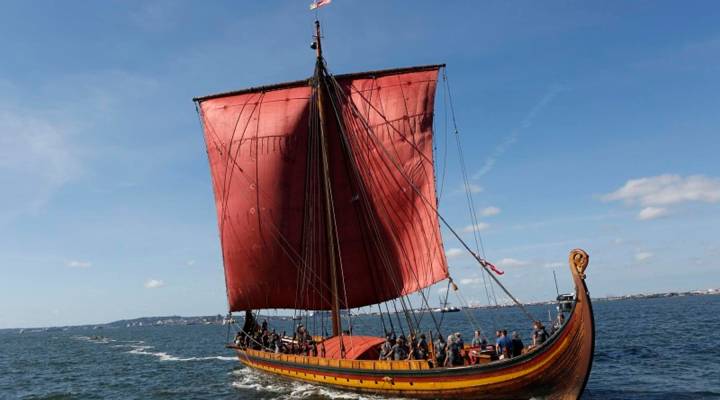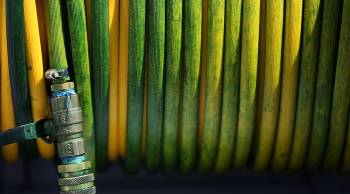
How woven cloth changed the course of history

The Vikings used wooden boats for conquests all over Europe. But was their real secret weapon the wool sails that propelled their warships? Marketplace host David Brancaccio sat down with author Kassia St Clair to talk about her new book, “The Golden Thread: How Fabric Changed History.” Below is an edited transcript of their conversation.
David Brancaccio: So, there’s naked, then there’s the fig leaf period of human history presumably, then animal pelts. But it’s your argument here in the book that it’s fabric, woven cloth, that really changes everything.
Kassia St Clair: Obviously, I’m completely and hopelessly biased because I wrote a book all about fabric, but I think that fabric is tremendously important and finds its way into all sorts of areas of life that we that we don’t expect.
Brancaccio: Well, I mean, really in the book for Vikings, fabric is like rocket fuel. It’s the sailcloth that pushes their ships so that trade can happen.
St Clair: Yes. This is one of my favorite chapters. It’s just absolutely astonishing to me when you think of wool, or at least when I think of wool, you think of woolly jumpers, and that is just not a material you would ever imagine would make good sailcloth. However, archaeologists were lucky enough to find a tiny piece of fabric that had been sort of stuffed into a roof in northern Norway, into a church roof. And this piece of cloth turned out to be a piece of sailcloth that had been made out of wool. And looking at this piece of cloth very closely, they were able to see that actually the Vikings have been able to make incredibly efficient sailcloth out of wool, which is just extraordinary. And this sailcloth was part of the technology that allowed them to get so far into trade, you know, sort of really across the world as it was then.
Brancaccio: What do archaeologists tell us? Where were humans weaving first? Do we have any sense?
St Clair: It’s really very hard to tell. One of the problems that fabric has is that for most of our history, we have been using natural fibers, and, of course, these are very liable to rot away. If you were to take off a cotton shirt and leave out in the parking lot, it would start to break down within a matter of a few months or years. And obviously, that’s not great when we’re looking back to the very origins because so much of what we presume was there is now gone. So the very first fibers that we know about are around 32,500 years old and were found completely by chance in a cave in Georgia in the Caucasus.
Brancaccio: What Americans would refer to as the other Georgia.
St Clair: The other Georgia. But, you know, we don’t know much about them. We know these these fibers were actually found, and accidentally, as I said, by a botanist who was actually looking for neolithic pollen, but when she looked into her microscope and instead saw these incredible fibers. We know that these were made out of linen. They seem to show quite a high level of sophistication. It appears that they were sort of twisted in various, relatively complex ways, and they also appear to have been dyed a really astonishing range of colors, not just black and brown and gray, but also turquoise and even a pink fiber was found. But whether this was part of a really wide system or not we don’t know, because the early record of fabric production is really spotty.
DB: Now, I was looking at the book and it really stood out, we think of the Industrial Revolution, I don’t know, as factory mass production pushed by steam that’s the driving force. But, in a sense, you’re arguing in the book that maybe it’s not the steam, but it’s the cotton that’s the crucial ingredient in the Industrial Revolution.
St Clair: Yes. This is not really a new idea. I’d love to claim credit for it, but, you know, it’s been known for quite a long time that cotton was really a key ingredient in the Industrial Revolution because it was really an important facet of international trade. Cloth that was produced in India could then be exported or imported, and this, you know, cotton kind of really greased the wheels of international trade.
Brancaccio: Among the many fascinating anecdotes is the account of the woman who early last century invented the one-piece bathing suit, which was regarded by some as indecent.
St Clair: Incredibly risqué. In fact, swimsuits have a rather troubled history. There’s one chapter that looks at swimsuits in much bit more depth and, in particular, the sort of swimsuit controversy, you know, that’s really very recent that took place after the Beijing Olympics. But yes, this sort of policing of what people wear during sport and what is kind of considered proper and improper is really fascinating and still very current. You still get, you know, there’s a recent controversy over what women were allowed to wear at an American university and whether just wearing sports bras to run in was sort of all right or not all right. We still struggle with has this idea of what is acceptable and which bits of the body can and can’t be shown during sport.
Brancaccio: The inventor of the one-piece swimsuit was actually arrested, it says here.
St Clair: Yes. So, you know, the very early swimsuits were obviously, you know, now we use a very stretchy fabrics that are very form fitting. But when they were very first created, they were made out of material that ended up being quite flappy. And, you know, when it became wet, also might become translucent, obviously not particularly desirable in swimwear. And so there was a lot of controversy during the very early days of the one-piece swimsuit. Yes.
Brancaccio: That’s interesting. You know, I had the sense of these big drapey bloomers. It’s hard with a modern perspective to understand that is risqué. But if the fabric suddenly becomes more see-through, you can see why early 20th century social norms might be provoked.
St Clair: Yes. I went back and had a look at a lot of the photographs that were taken at the very kind of the early Olympics. And it has to be said that there are an awful lot of surviving photographs of the British swim team who were one of the first teams to sort of adopt these swimsuits, and the photographers really seem to have enjoyed taking an awful lot of photographs of this poor soaking wet swim team.
There’s a lot happening in the world. Through it all, Marketplace is here for you.
You rely on Marketplace to break down the world’s events and tell you how it affects you in a fact-based, approachable way. We rely on your financial support to keep making that possible.
Your donation today powers the independent journalism that you rely on. For just $5/month, you can help sustain Marketplace so we can keep reporting on the things that matter to you.


















